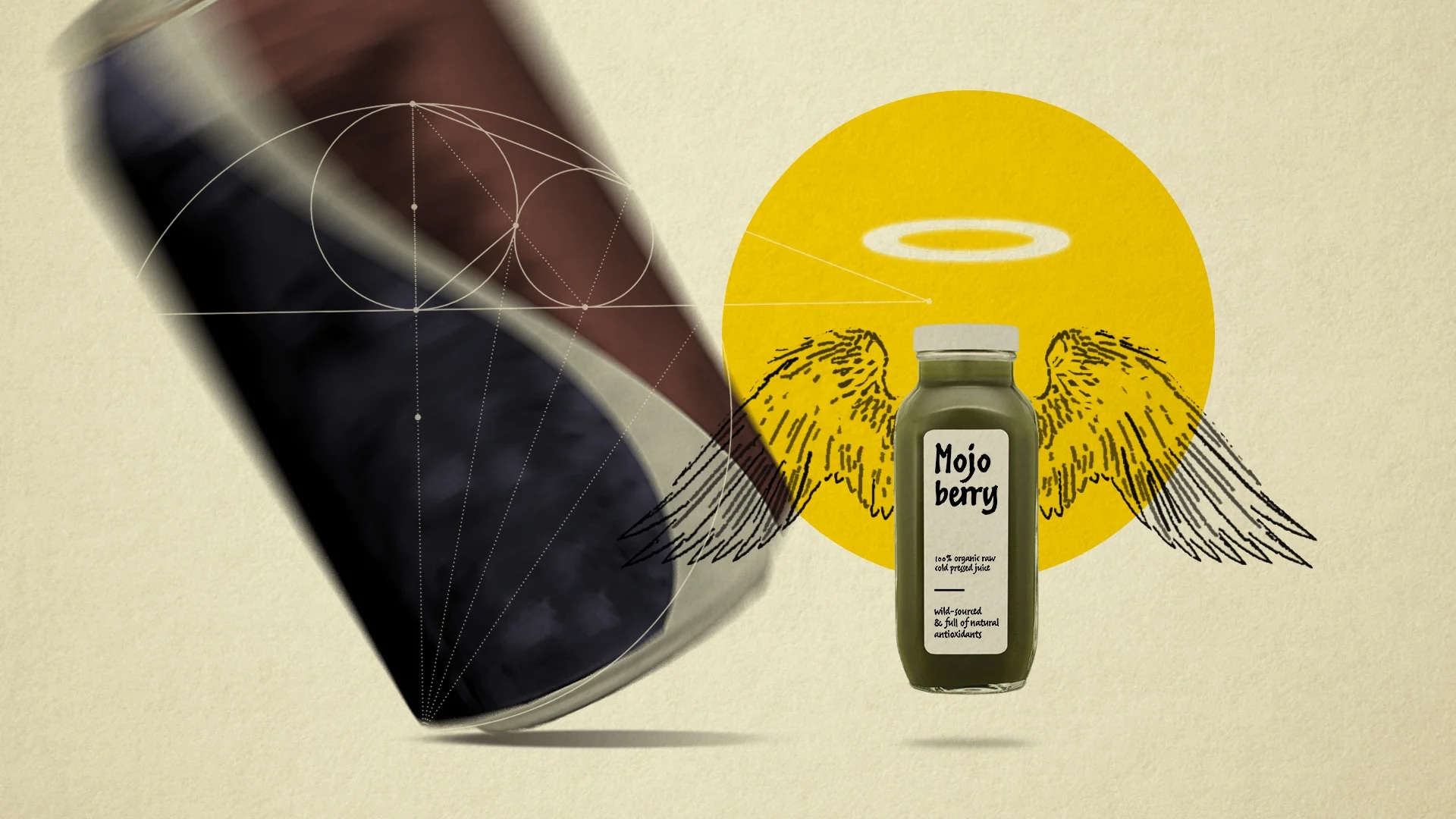Big Food, Small Food
If this hasn’t happened to you, make it happen. Go to a shiny modern retail store near you, and stroll the juice shelves. Your eye is caught by a glass bottle with a metal cap, a mini-replica of the milk bottles of your youth. You take in the charmingly ‘un’-designed bottle.
Austere titling identifies the grass-green juice as cold-pressed Mojoberry, wild-sourced, and full of natural antioxidants. Mixed only with spring water, it promotes healthy metabolism, and is plucked by Melgrovian gatherer communities. Like it? Yes, especially when you learn that 1% of gross sales go to keep the intellectual property rights within the forester groups.
Perhaps we have reached a point where it may be incumbent on every food business to locate itself on an ethical spectrum, even if its product is 100% manufactured, and synthesised entirely from the purest chemicals. Deep Design probes the phenomenon and salutes with both a nod and a wink, the sea of new brands that concern themselves with bettering the human condition.

Perennial themes in Heath/Ethical brands — a range of antidotes. The folksy strand: hand lettering, intricate, irregular shapes, the medieval or modern apothecary strand: plain labels, and the sciency kind with a pristine, minimal laboratory chic.
In a sense, it was always thus.
For selling food has always been about health and trust; no purchase or sale has greater consequence. If the last century of food is partly about packaged convenience, then it’s also about its malcontents—processing to enhance taste, texture and shelf-life often achieved at the cost of lower nutrient density.
Health / ethical brands can be viewed as a corrective to modernity, arising from the body of society, using modernity against itself, and running contemporaneously with it. As analogy, consider the human body, which can makes antibodies against pathogens, and hormones to digest a range of foods. It is exquisitely evolved to fight or adapt, and both the stressors and their anti-stressors go back many aeons.
Health / ethical brands can be viewed as a corrective to modernity, arising from the body of society, using modernity against itself, and running contemporaneously with it.
Like the analogy, the opposition has evolved along with the mainstream it seeks to correct. As early as the 1930s, Robert Bootzin (1914-2004, also ‘Gypsy Boots’), an early icon of fitness and natural living in America, lived with other ‘tribesmen’ in caves, wore long hair, and lived off seasonal fruit. A media figure, he likely opened the door to alternate living, California style: yoga, vegetarianism, abstinence and organic food. The title of his cult book “Bare Feet and Good Things to Eat” says it all.

Robert Bootzin (1914-2004, also ‘Gypsy Boots’) an early American icon of fitness and natural living
Food processing, new materials and manufacturing (plastics and aluminium), and new distribution formats are by themselves, merely modern enablements. What turns them into the sort of profound, discontinuous change that characterises 20th century modernity is that they serve the large food companies which have changed what food means. Food is no longer local, and we are distanced from the growers; we consume brands and variants, not varieties. It is hardly perishable, tastier than nature could manage and standardised. Its critics call it Big Food.
Accordingly, Big Food’s packaging, and that of its followers, stresses a kind of screaming, base attractiveness, optimised for the shelf, and conveyed through images that strain to detail (un?)natural perfection, apart from corporate reliability.
As with bodily stressors, Big Food is resisted by multiple antigens: local food, slow food, organic food, sustainable farming. Let’s call it Small Food. Acting in concert are new-age spirituality, fair trade, the rise in status of traditional knowledge, multiculturalism, and the public scrutiny that’s a feature of the internet age.
Tying some of these strands together is a lurking distrust of the establishment, comprising government, corporations, media and sections of intelligentsia. It is seen by critics as a cartel of interests and opinion: buy, eat, and be happy. Big Food is compared to Big Tobacco, and even food science is suspected of commissioned research.
These perennial themes suggest the ways in which Small Food packages itself. A whole taxonomy of design approaches offers a rage of antidotes. The folksy strand takes the ideal of artisanship to a delightful extreme: hand lettering and intricate, irregular shapes. They stress their distant, wild, sources, often with carefully enunciated ‘ethnic’ values. Another kind professes to be a medieval or modern apothecary, a herbalist, who has merely labelled his potions in the plainest of packs. Then there are the sciency types, stealing a leaf from the multinational playbook with a pristine, minimal laboratory chic. Mojoberry, in paragraph 1, might well be an amalgam of all of these.
Perennial themes in Heath/Ethical brands — a range of antidotes. The folksy strand: hand lettering, intricate, irregular shapes, the medieval or modern apothecary strand: plain labels, and the science-y kind with a pristine, minimal laboratory chic.

Common to all of these is an ethical approach to identity. Sources are all important to food, but the logic of manufacture, scale and standardisation makes authentic origins hard to claim for Big Food. Small Food exploits this weakness and paints itself as a person or community you can know, and thus claims a kind of personal authenticity. Trader Joe, as a name exploits this: remember that Small Food isn’t necessarily all that small as business.
Each of these design styles implies a claim to innocence of marketing, branding and commercial slickness: the herbalist, scientist and local grower all strive to appear artless. Patanjali’s gauche packaging has been claimed to fuel its stupendous rise; on the other hand, the super successful brand Innocent is an archetype of an extremely artful artlessness.
Patanjali’s gauche packaging has been claimed to fuel its stupendous rise; on the other hand, the super successful brand Innocent is an archetype of an extremely artful artlessness.
It is now possible to look at these healthful heroes with a cynical eye, as the ethical bandwagon seems as full of pretenders as any other. Has the antibody started to resemble a virus, which the immune system cannot detect? If so, Big Food can launch or acquire ethical brands. Great bodies co-opt small ones to survive: our cells evolved from simple bacteria.
Bite by bite, sip by sip, Small Food’s positive antagonism might yet strengthen the food trade, making it more transparent, fair and wholesome. At least we can hope: watch those packs carefully.
____________________
First published in a slightly modified form ‘Big Food, Small Food’ in Business Standard, 17 February, in Deep Design, a monthly column by Itu Chaudhuri.

